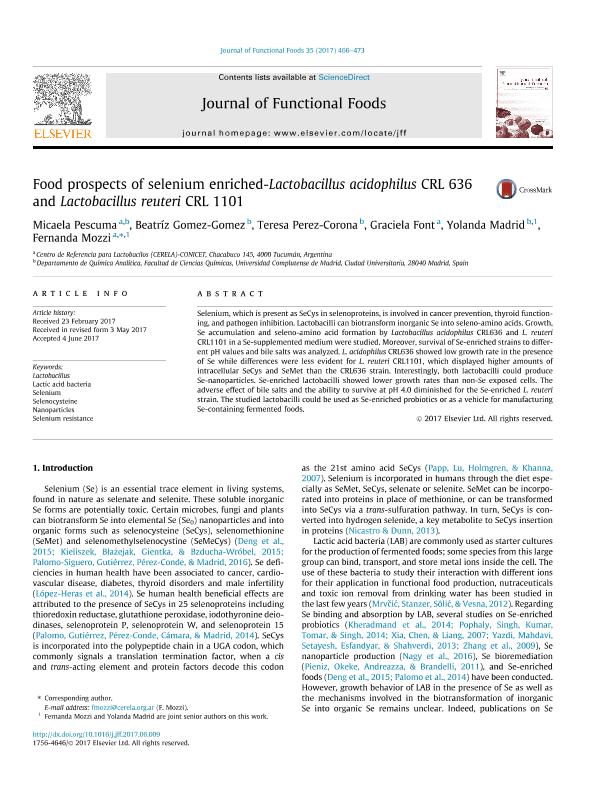Mostrar el registro sencillo del ítem
dc.contributor.author
Pescuma, Micaela

dc.contributor.author
Gomez Gomez, Beatríz
dc.contributor.author
Perez Corona, Teresa
dc.contributor.author
Font, Graciela Maria

dc.contributor.author
Madrid Albarrn, Yolanda

dc.contributor.author
Mozzi, Fernanda Beatriz

dc.date.available
2018-03-26T21:18:04Z
dc.date.issued
2017-08
dc.identifier.citation
Pescuma, Micaela; Gomez Gomez, Beatríz; Perez Corona, Teresa; Font, Graciela Maria; Madrid Albarrn, Yolanda; et al.; Food prospects of selenium enriched-Lactobacillus acidophilus CRL 636 and Lactobacillus reuteri CRL 1101; Elsevier Ltd; Journal of Functional Foods; 35; 8-2017; 466-473
dc.identifier.issn
1756-4646
dc.identifier.uri
http://hdl.handle.net/11336/40073
dc.description.abstract
Selenium, which is present as SeCys in selenoproteins, is involved in cancer prevention, thyroid functioning, and pathogen inhibition. Lactobacilli can biotransform inorganic Se into seleno-amino acids. Growth, Se accumulation and seleno-amino acid formation by Lactobacillus acidophilus CRL636 and L. reuteri CRL1101 in a Se-supplemented medium were studied. Moreover, survival of Se-enriched strains to different pH values and bile salts was analyzed. L. acidophilus CRL636 showed low growth rate in the presence of Se while differences were less evident for L. reuteri CRL1101, which displayed higher amounts of intracellular SeCys and SeMet than the CRL636 strain. Interestingly, both lactobacilli could produce Se-nanoparticles. Se-enriched lactobacilli showed lower growth rates than non-Se exposed cells. The adverse effect of bile salts and the ability to survive at pH 4.0 diminished for the Se-enriched L. reuteri strain. The studied lactobacilli could be used as Se-enriched probiotics or as a vehicle for manufacturing Se-containing fermented foods.
dc.format
application/pdf
dc.language.iso
eng
dc.publisher
Elsevier Ltd
dc.rights
info:eu-repo/semantics/openAccess
dc.rights.uri
https://creativecommons.org/licenses/by-nc-nd/2.5/ar/
dc.subject
Lactic Acid Bacteria
dc.subject
Lactobacillus
dc.subject
Nanoparticles
dc.subject
Selenium
dc.subject
Selenium Resistance
dc.subject
Selenocysteine
dc.subject.classification
Otras Ciencias Biológicas

dc.subject.classification
Ciencias Biológicas

dc.subject.classification
CIENCIAS NATURALES Y EXACTAS

dc.title
Food prospects of selenium enriched-Lactobacillus acidophilus CRL 636 and Lactobacillus reuteri CRL 1101
dc.type
info:eu-repo/semantics/article
dc.type
info:ar-repo/semantics/artículo
dc.type
info:eu-repo/semantics/publishedVersion
dc.date.updated
2018-03-26T18:25:39Z
dc.journal.volume
35
dc.journal.pagination
466-473
dc.journal.pais
Países Bajos

dc.journal.ciudad
Amsterdam
dc.description.fil
Fil: Pescuma, Micaela. Consejo Nacional de Investigaciones Científicas y Técnicas. Centro Científico Tecnológico Conicet - Tucuman. Centro de Referencia Para Lactobacilos; Argentina. Universidad Complutense de Madrid; España
dc.description.fil
Fil: Gomez Gomez, Beatríz. Universidad Complutense de Madrid; España
dc.description.fil
Fil: Perez Corona, Teresa. Universidad Complutense de Madrid; España
dc.description.fil
Fil: Font, Graciela Maria. Consejo Nacional de Investigaciones Científicas y Técnicas. Centro Científico Tecnológico Conicet - Tucuman. Centro de Referencia Para Lactobacilos; Argentina
dc.description.fil
Fil: Madrid Albarrn, Yolanda. Universidad Complutense de Madrid; España
dc.description.fil
Fil: Mozzi, Fernanda Beatriz. Consejo Nacional de Investigaciones Científicas y Técnicas. Centro Científico Tecnológico Conicet - Tucuman. Centro de Referencia Para Lactobacilos; Argentina
dc.journal.title
Journal of Functional Foods
dc.relation.alternativeid
info:eu-repo/semantics/altIdentifier/doi/http://dx.doi.org/10.1016/j.jff.2017.06.009
dc.relation.alternativeid
info:eu-repo/semantics/altIdentifier/url/https://www.sciencedirect.com/science/article/pii/S1756464617303250
Archivos asociados
